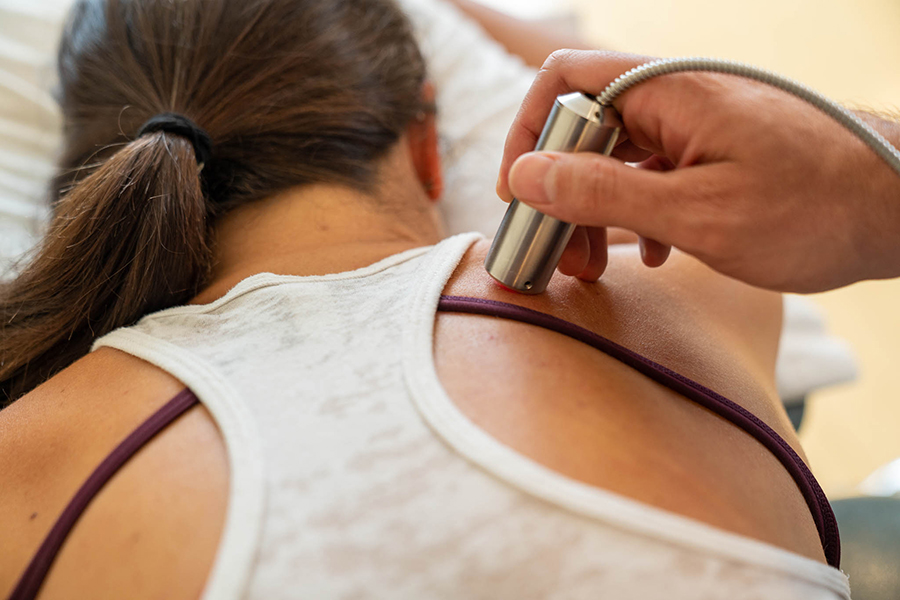PT Guide to Shoulder Impingement
Jan 12, 2015

Physical Therapist’s Guide to Shoulder Impingement
Shoulder impingement syndrome occurs as the result of chronic and repetitive compression or “impingement” of the rotator-cuff tendons in the shoulder, causing pain and movement problems. It can also be caused by an injury to the shoulder. People who perform repetitive or overhead arm movements, such as manual laborers or athletes who raise their arms repeatedly overhead (ie, weightlifters and baseball pitchers), are most at risk for developing a shoulder impingement. Poor posture can also contribute to its development. If left untreated, a shoulder impingement can lead to more serious conditions, such as a rotator cuff tear. Physical therapists can help decrease pain, and improve shoulder motion and strength in people with shoulder impingements.What is Shoulder Impingement?
Shoulder impingement syndrome is a condition that develops when the rotator-cuff tendons in the shoulder are overused or injured, causing pain and movement impairments. Shoulder impingement syndrome may also be referred to as “subacromial” impingement syndrome because the tendons, ligaments, and bursa under the “acromion” can become pinched or compressed. The shoulder is made up of 3 bones called the humerus, the scapula, and the clavicle. The acromion is a bony prominence on the top of the scapula, which can be felt as a bump at the tip of the shoulder. The rotator cuff tendon and the bursa sit beneath the acromion. The bursa is a fluid-filled sac that provides a cushion between the bony acromion and the rotator cuff tendon, and it can become compressed underneath the acromion. Impingement symptoms can occur when compression and microtrauma harm the tendons. There are several causes to shoulder impingement syndrome including:- Repetitive overhead movements, such as golfing, throwing, racquet sports, and swimming, or frequent overhead reaching or lifting.
- Injury, such as a fall, where the shoulder gets compressed.
- Bony abnormalities of the acromion, which narrow the subacromial space.
- Osteoarthritis in the shoulder region.
- Poor rotator cuff and shoulder blade muscle strength, causing the humeral head to move abnormally.
- Thickening of the bursa.
- Thickening of the ligaments in the area.
- Tightness of the soft tissue around the shoulder joint called the joint capsule.
How Does it Feel?
Individuals with shoulder impingement may experience:- Restriction in shoulder motion with associated weakness in movement patterns, such as reaching overhead, behind the body, or out to the side.
- Pain in the shoulder when moving the arm overhead, out to the side, and beside the body.
- Pain and discomfort when attempting to sleep on the involved side.
- Pain with throwing motions and other dynamic movement patterns.
How Is It Diagnosed?
A physical therapist will perform an evaluation and ask you questions about the pain you are feeling, and other symptoms. Your physical therapist may perform strength and motion tests on your shoulder, ask about your job duties and hobbies, evaluate your posture, and check for any muscle imbalances and weakness that can occur between the shoulder and the scapular muscles. Special tests involving gentle movements of your arm and shoulder may be performed to determine exactly which tendons are involved. X-rays may also be taken to identify other conditions that could be contributing to your discomfort, such as bony spurs or abnormalities, or arthritis.How Can a Physical Therapist Help?
It is important to get proper treatment for shoulder impingement as soon as it occurs. Secondary conditions can result from the impingement of the tissues in the shoulder, including irritation of the bursa and rotator-cuff tendinitis or tears. Physical therapy can be very successful in treating shoulder impingement syndrome. You will work with your physical therapist to devise a treatment plan that is specific to your condition and goals. Your individual treatment program may include: Pain Management. Your physical therapist will help you identify and avoid painful movements, as well as correct abnormal postures to reduce impingement compression. Therapeutic modalities, like iontophoresis (medication delivered through an electrically charged patch) and ultrasound may be applied. Ice may also be helpful to reduce pain. Manual Therapy. Your physical therapist may use manual techniques, such as gentle joint movements, soft-tissue massage, and shoulder stretches to get your shoulder moving properly, so that the tendons and bursa avoid impingement. Range-of-Motion Exercises. You will learn exercises and stretches to help your shoulder and shoulder blade move properly, so you can return to reaching and lifting without pain. Strengthening Exercises. Your physical therapist will determine which strengthening exercises are right for you, depending on your specific condition. Often with shoulder impingement syndrome, the head of the humerus tends to drift forward and upward due to the rotator-cuff muscles becoming weak. Strengthening the rotator-cuff and scapular muscles helps position the head of the humerus bone down and back to ease the impingement. You may also perform resistance training exercises to strengthen your weaker muscles. You will receive a home-exercise program to continue your strengthening long after you have completed your formal physical therapy. Patient Education. Learning proper posture is an important part of rehabilitation. For example, when your shoulders roll forward as you lean over a computer, the tendons in the front of the shoulder can become impinged. Your physical therapist will work with you to help improve your posture, and may suggest adjustments to your work station and work habits. Functional Training. As your symptoms improve, your physical therapist will teach you how to correctly perform a range of functions using proper shoulder mechanics, such as lifting an object onto a shelf or throwing a ball. This training will help you return to pain-free function on the job, at home, and when playing sports.Can this Injury or Condition be Prevented?
Shoulder impingement syndrome can be prevented by:- Maintaining proper strength in the shoulder and shoulder-blade muscles.
- Regularly stretching the shoulders, neck, and middle-back region.
- Maintaining proper posture and shoulder alignment when performing reaching and throwing motions.
- Avoiding forward-head and rounded-shoulder postures (being hunched over) when spending long periods of time sitting at a desk or computer.
Real Life Experiences
Bob is a 33-year-old engineer who spends many hours drafting, creating spreadsheets, and writing reports on his computer at work. He enjoys playing tennis after work a few times a week. Recently, Bob began feeling pain in his right shoulder when he reached overhead to serve a tennis ball. He felt the same kind of pain when he tried to throw a softball during his daughter’s softball practice. After a few weeks, the shoulder pain worsened and Bob began to have difficulty just reaching into a cupboard to get a glass at home. Last night, the pain in his shoulder woke him up every time he rolled onto it. He decided to call his physical therapist. Bob’s physical therapist performed a full evaluation of his shoulder. She noted he felt pain with certain shoulder movements, and had difficulty performing them due to weakness in the rotator-cuff and scapular muscles. She also saw that he had a rounded posture when sitting. She performed range-of-motion and other special tests on his shoulder. Based on her findings, she diagnosed shoulder impingement syndrome. Bob and his physical therapist worked together to establish short- and long-term goals for his treatment. She prescribed ice to help decrease his pain, and taught him some gentle movement and strengthening exercises. She performed manual (hands-on) therapy on his shoulder to gently mobilize the joints and tissues. Bob’s physical therapist showed him how to improve his posture when sitting at his desk at work, and taught him a home-exercise program of stretching, strengthening, and postural exercises, which she modified throughout the course of his therapy as his condition improved. After a few weeks of diligent physical therapy sessions and performing his home-exercise program, Bob reported he was able to raise his shoulder completely overhead without pain or limitation, and sleep on his side comfortably at night. Today, Bob is back playing tennis pain-free, and is able to “throw long” for his daughter during softball practice.What Kind of Physical Therapist Do I Need?
All physical therapists are prepared through education and experience to treat shoulder impingement syndrome. However, you may want to consider:- A physical therapist who is experienced in treating people with shoulder impingement syndrome. Some physical therapists have a practice with an orthopedic or musculoskeletal focus.
- A physical therapist who is a board-certified clinical specialist, or who completed a residency or fellowship in orthopedic or sports physical therapy. This therapist has advanced knowledge, experience, and skills that may apply to your condition.
- Get recommendations from family and friends or from other health care providers.
- When you contact a physical therapy clinic for an appointment, ask about the physical therapists’ experience in helping people who have shoulder impingement syndrome. During your first visit with the physical therapist, be prepared to describe your symptoms in as much detail as possible, and say what makes your symptoms worse.
Further Reading
The American Physical Therapy Association (APTA) believes that consumers should have access to information that could help them make health care decisions and also prepare them for their visit with their health care provider. The following articles provide some of the best scientific evidence for the treatment of shoulder impingement. The articles report recent research and give an overview of the standards of practice both in the United States and internationally. The article titles are linked either to a PubMed* abstract of the article or to free full text, so that you can read it or print out a copy to bring with you to your health care provider. Khan Y, Nagy MT, Malal J, Waseem M. The painful shoulder: shoulder impingement syndrome. Open Orthop J. 2013;7:347–351.Free Article. Wilk KE, Hooks TR, Macrina LC. The modified sleeper stretch and modified cross-body stretch to increase shoulder internal rotation range of motion in the overhead throwing athlete. J orthop Sports Phys Ther. 2013;43(12):891–894. Free Article. De Mey K, Danneels LA, Cagnie B, Huyghe L, Seyns E, Cools AM. Conscious correction of scapular orientation in overhead athletes performing selected shoulder rehabilitation exercises: the effect on trapezius muscle activation measured by surface electromyography. J Orthop Sports Phys Ther. 2013;43(1):3–10. Free Article. Struyf F, Nijs J, Baeyens JP, Mottram S, Meeusen R. Scapular positioning and movement in unimpaired shoulders, shoulder impingement syndrome, and glenohumeral instability. Scand J Med Sci Sports. 2011;21(3):352–358. Article Summary on PubMed. Castagna A, Garofalo R, Cesari E, Markopoulos N, Borroni M, Conti M. Posterior superior internal impingement: an evidence-based review [erratum in: Br J Sports Med. 2010;44(8):604.]. Br J Sports Med. 2010;44(5):382–388. Article Summary on PubMed. Faber E, Kuiper JI, Burdorf A, Miedema HS, Verhaar JA. Treatment of impingement syndrome: a systematic review of the effects on functional limitations and return to work. J Occup Rehabil. 2006;16(1):7–25. Article Summary on PubMed. *PubMed is a free online resource developed by the National Center for Biotechnology Information (NCBI). PubMed contains millions of citations to biomedical literature, including citations in the National Library of Medicine’s MEDLINE database. Authored by Julie A. Mulcahy, PT, MPT. Reviewed by the MoveForwardPT.com editorial board.For informational purposes only.











